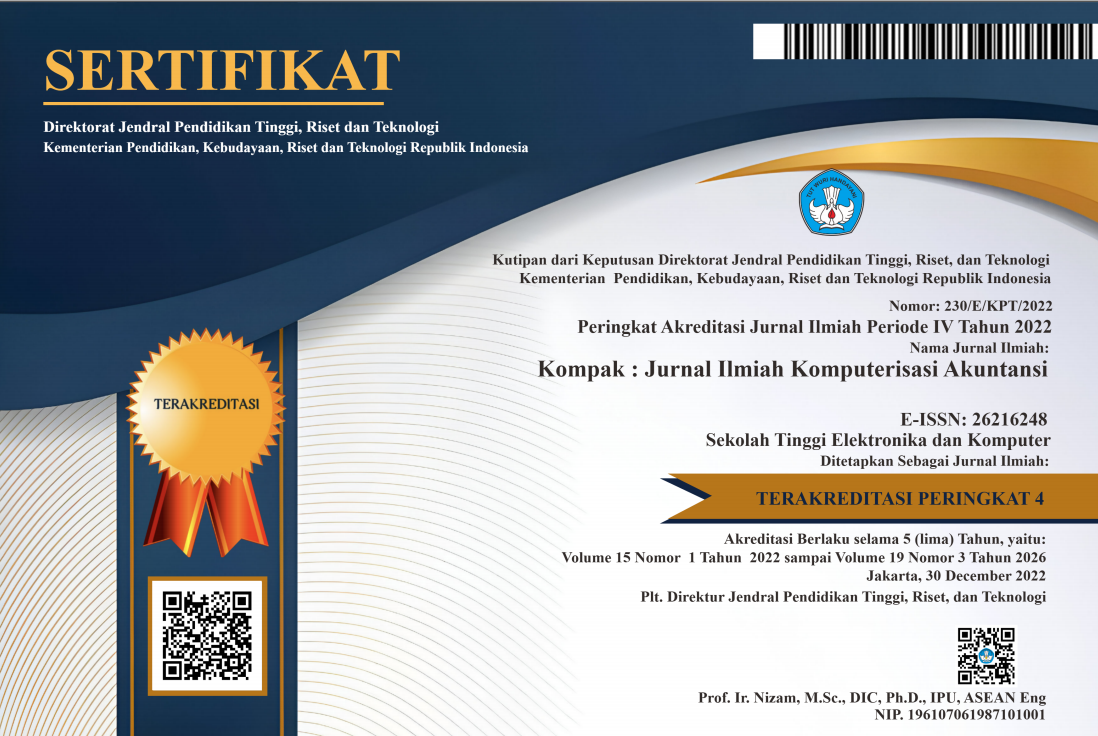RESEARCH TREND OF WORKING CAPITAL MANAGEMENT
DOI:
https://doi.org/10.51903/kompak.v17i1.1862Kata Kunci:
Working Capital Management, Bibliometric, Biblioshiny, VOS Viewer, ScopusAbstrak
Given the importance of working capital in firm dynamics, the main objective of this research is to highlight the main gaps and insights in the working capital literature and suggest future research, as well as to know the development trend of working capital management research published by leading journals. For this reason, a bibliometric analysis was carried out using bibliographic information from Scopus for the topic "working capital management." The method used in this quantitative research uses Bibliometric analysis. A quantitative analytic approach was used to analyze published studies from 1992 to 2022. The mapping software used was VOS Viewer and biblioshiny R to analyze the data obtained and visualize research trend data. The results of the analysis show that the development of articles with the theme of Working Capital Management continues to increase from year to year, although not constant and essential. The most published authors of articles on Working Capital Management are Karri, T. and Michalski, G. The United Kingdom is the country most cited. 2019 was the year with the highest number of publications on Working Capital Management. The International Journal of Recent Technology and Engineering is the highest source that occurs in 2019. Business, Management and Accounting are the most mentioned trending topics with a total of 38%.
Referensi
[2] A. Pritchard, “Statistical bibliography or bibliometrics,” J. Doc., vol. 25, pp. 348–349, 1969.
[3] G. P. Dias, “Fifteen years of e-government research in Ibero-America: A bibliometric analysis,” Gov. Inf. Q., vol. 36, no. 3, pp. 400–411, 2019, doi: 10.1016/j.giq.2019.05.008.
[4] O. Ellegaard and J. A. Wallin, “The bibliometric analysis of scholarly production: How great is the impact?,” Scientometrics, vol. 105, no. 3, pp. 1809–1831, 2015, doi: 10.1007/s11192-015-1645-z.
[5] N. J. van Eck and L. Waltman, “Software survey: VOSviewer, a computer program for bibliometric mapping,” Scientometrics, vol. 84, no. 2, pp. 523–538, 2010, doi: 10.1007/s11192-009-0146-3.
[6] X. Zhu, X. Meng, and M. Zhang, “Application of multiple criteria decision making methods in construction: A systematic literature review,” J. Civ. Eng. Manag., vol. 27, no. 6, pp. 372–403, 2021, doi: 10.3846/jcem.2021.15260.
[7] I. Maula, “Pengaruh Manajemen Modal Kerja Terhadap Profitabilitas ( Studi Pada Perusahaan Manufaktur Sektor Barang Konsumsi Yang Terdaftar Di Bursa Efek Indonesia Periode 2012-2015 ) The Effect Of Working Capital Management On ( Study On Manufacturing Companies Work,” pp. 1–17, 2016.
[8] D. Rusli and T. B. Dumaris, “Pengaruh Manajemen Modal Kerja Terhadap Financial Distress dengan Ukuran Perusahaan sebagai Variabel Kontrol pada Perusahaan Sektor Pertambangan,” J. Akunt. dan Manaj., vol. 17, no. 02, pp. 01–10, 2020, doi: 10.36406/jam.v17i02.331.
[9] M. Sholahuddin, S. O. Manullang, and D. Sari, “Understanding review of economic loss due to government policy respond to the COVID-19 disruption in Indonesia,” Int. J. business, Econ. Manag., vol. 4, no. 1, pp. 180–188, 2021, doi: 10.31295/ijbem.v4n1.1479.
[10] A. N. Praswati, N. P. Sari, and S. Murwanti, “Youth Entrepreneurial Intention : Theory of Planned Behaviour and Social Cognitive Theory,” vol. 7, 2022.
[11] A. Sirait, “Analisis Manajemen Modal Kerja Sehubungan Dengan Pengukuran Profitabilitas UMKM (Studi Pada SP Alumunium),” J. Chem. Inf. Model., vol. 53, no. 9, p. 22, 2019.
[12] C. Pugnetti and S. Elmer, “Self-assessment of driving style and the willingness to share personal information,” J. Risk Financ. Manag., vol. 13, p. 53, 2020.
[13] A. N. (Universitas B. Adi, “Pengaruh Manajemen Modal Kerja Terhadap Profitabilitas (Studi Pada Perusahaan Manufaktur Sektor Barang Konsumsi Yang Terdaftar Di Bursa Efek Indonesia Periode 2012-2015 ) The Effect Of Working Capital Management On ( Study On Manufacturing Companies Work,” pp. 1–17, 2015.
[14] Firmansyah, R., & Yovita, L. "Pengaruh Firm Size, Financial Leverage, dan Profitabilitas terhadap Return Saham (Studi pada Perusahaan Sektor Telekomunikasi di BEI Periode 2017-2022)," J. Ekonomi dan Bisnis, vol. 2, no. 4, pp. 223-234.
[15] A. Rusydiana, N. Tubastuvi, and U. M. Purwokerto, “Aplikasi Biblioshiny R pada Riset Keuangan Mikro Islam DigitalCommons @ University of Nebraska - Lincoln Aplikasi Biblioshiny R pada Riset Keuangan Mikro Islam,” no. April, 2021.
[16] N. Zainal, M. H. Bakri, L. S. Hook, S. Zaini, M. Faizal, and U. T. Mara, “Validity Of Fisher Effect Theory: Evidence from The Conventional and Islamic Money Market in Malaysia,” Qual. - Access to Success, vol. 22, no. 184, pp. 64–72, 2021, doi: 10.47750/qas/22.184.07.
[17] L. H. Handoko, “Artikel asli Analisis bibliometrik dan visualisasi artikel ekonomi dan keuangan Islam yang terindeks Scopus oleh penulis Indonesia,” no. September, 2020, doi: 10.6087/kcse.213.
[18] M. N. Hudha, I. Hamidah, A. Permanasari, A. G. Abdullah, I. Rachman, and T. Matsumoto, “Low carbon education: A review and bibliometric analysis,” Eur. J. Educ. Res., vol. 9, no. 1, pp. 319–329, 2020, doi: 10.12973/eu-jer.9.1.319.
[19] N. Aktas, E. Croci, and D. Petmezas, “Is working capital management value-enhancing? Evidence from firm performance and investments,” J. Corp. Financ., vol. 30, no. 1, pp. 98–113, 2015, doi: 10.1016/j.jcorpfin.2014.12.008.
[20] S. Ahasan, F. N. Zaman, and T. Ahmed, “Perspective of Circular Economy in Bangladesh: A Comprehensive Review Towards Ship Demolition Industry,” in Proceedings of the International Conference on Industrial Engineering and Operations Management, 2021, pp. 2375–2385.
[21] S. I. Egwunatum, A. C. Anumudu, E. C. Eze, and I. A. Awodele, “Total quality management (TQM) implementation in the Nigerian construction industry,” Eng. Constr. Archit. Manag., vol. 29, no. 1, pp. 354–382, 2022, doi: 10.1108/ECAM-08-2020-0639.
[22] G. Zimon and H. Tarighi, “Effects of the COVID-19 Global Crisis on the Working Capital Management Policy: Evidence from Poland,” J. Risk Financ. Manag., vol. 14, no. 4, p. 169, 2021, doi: 10.3390/jrfm14040169.
[23] A. Noorizadeh, T. Kuosmanen, and A. Peltokorpi, “Effective purchasing reallocation to suppliers: insights from productivity dynamics and real options theory,” Int. J. Prod. Econ., vol. 233, 2021, doi: 10.1016/j.ijpe.2020.108002.
[24] H. Wu, Q. K. Qian, A. Straub, and H. Visscher, “Stakeholder Perceptions of Transaction Costs in Prefabricated Housing Projects in China,” J. Constr. Eng. Manag., vol. 147, no. 1, 2021, doi: 10.1061/(ASCE)CO.1943-7862.0001947.
[25] A. Klinčar and J. Zoroja, “Supply Chain Management Supported by E-Invoicing: Cluster Analysis Approach to E-Invoicing,” Int. J. E-Services Mob. Appl., vol. 13, no. 2, pp. 43–59, 2021, doi: 10.4018/IJESMA.2021040103.
[26] L. R. Lima, L. H. Alencar, and M. H. Alencar, “Analysis of the Perspectives of the Stakeholders in Sustainability Management in Civil Construction: A Literature Review,” in 2021 IEEE International Conference on Industrial Engineering and Engineering Management, IEEM 2021, 2021, pp. 974–978. doi: 10.1109/IEEM50564.2021.9672599.














.png)



